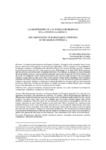Mostrar o rexistro simple do ítem
La orientación de las iglesias románicas en la Península Ibérica
| dc.contributor.author | Pérez-Valcárcel, Juan | |
| dc.contributor.author | Pérez-Palmero, Victoria | |
| dc.date.accessioned | 2021-02-08T11:09:26Z | |
| dc.date.available | 2021-02-08T11:09:26Z | |
| dc.date.issued | 2019 | |
| dc.identifier.citation | Pérez Valcárcel, Juan, y Victoria Pérez Palmero. 2019. «La orientación de las Iglesias románicas en la Península Ibérica». Anuario de Estudios Medievales 49 (2):761-91. https://doi.org/10.3989/aem.2019.49.2.14. | es_ES |
| dc.identifier.issn | 0066-5061 | |
| dc.identifier.uri | http://hdl.handle.net/2183/27306 | |
| dc.description.abstract | [Resumen] Las iglesias prerrománicas en Hispania (España y Portugal) están orientadas hacia el este, pero se observa un cierto número de desviaciones importantes. Por el contrario, la casi totalidad de las iglesias románicas en Hispania están orientadas hacia el este con desviaciones que sólo se apartan de posibles posiciones del orto solar en pocos casos. Únicamente en la Baja Edad Media aparecen iglesias góticas con orientaciones claramente diferentes. Sin embargo, la mayoría no están orientadas al este geográfico preciso, sino que pueden presentar variaciones de más de 30º hacia el norte y hacia el sur. Es justamente lo que varía la posición del orto solar a lo largo del año y esto nos permite calcular con precisión de unos pocos días, el día concreto en que fueron orientadas. En este artículo trataremos de definir cuáles fueron los criterios utilizados y si ese día tiene un significado simbólico, litúrgico o funcional. También se analizará el sistema de medición necesario para una determinación precisa de dicho día y los factores que deben ser tenidos en cuenta en dicho cálculo, para conseguir la precisión adecuada, así como las conclusiones del estudio. | es_ES |
| dc.description.abstract | [Abstract] Pre-Romanesque churches in Hispania (Spain and Portugal) generally face east, but very significant deviations can sometimes be observed. In contrast, almost all Romanesque churches in Hispania are oriented towards the east with deviations that vary from possible positions of the sunrise in only a very few cases. Only in the Late Middle Ages do Gothic churches appear with clearly different orientations. However, most are not oriented towards precise geographical east, but can display variations of more than 30 degrees north and south. This is precisely the variation in the position of sunrise in the course of the year, and it allows us to calculate the particular day when they were laid out within a few days. This article will attempt to define what the criteria used were and if that day had any symbolic, liturgical or functional significance. The measurement system required for an accurate determination of the day and the factors to be taken into account in the calculation to achieve the appropriate precision are also analysed. The conclusions of the study are also included. | es_ES |
| dc.language.iso | spa | es_ES |
| dc.publisher | CSIC | es_ES |
| dc.relation.uri | https://doi.org/10.3989/aem.2019.49.2.14 | es_ES |
| dc.rights | Atribución 4.0 | es_ES |
| dc.rights.uri | http://creativecommons.org/licenses/by/4.0/ | * |
| dc.subject | Iglesias románicas | es_ES |
| dc.subject | Orientación de las iglesias | es_ES |
| dc.subject | Orto solar | es_ES |
| dc.subject | Medida de la orientación | es_ES |
| dc.subject | Orientaciones simbólicas | es_ES |
| dc.subject | Orientaciones funcionales | es_ES |
| dc.subject | Romanesque churches | es_ES |
| dc.subject | Church orientation | es_ES |
| dc.subject | Sunrise | es_ES |
| dc.subject | Orientation measurement | es_ES |
| dc.subject | Symbolic orientations | es_ES |
| dc.subject | Functional orientations | es_ES |
| dc.title | La orientación de las iglesias románicas en la Península Ibérica | es_ES |
| dc.title.alternative | The Orientation of Romanesque Churches in the Iberian Peninsula | es_ES |
| dc.type | info:eu-repo/semantics/article | es_ES |
| dc.rights.access | info:eu-repo/semantics/openAccess | es_ES |
| UDC.journalTitle | Anuario de Estudios Medievales | es_ES |
| UDC.volume | 49 | es_ES |
| UDC.issue | 2 | es_ES |
| UDC.startPage | 761 | es_ES |
| UDC.endPage | 791 | es_ES |
Ficheiros no ítem
Este ítem aparece na(s) seguinte(s) colección(s)
-
GI-GEA - Artigos [66]






